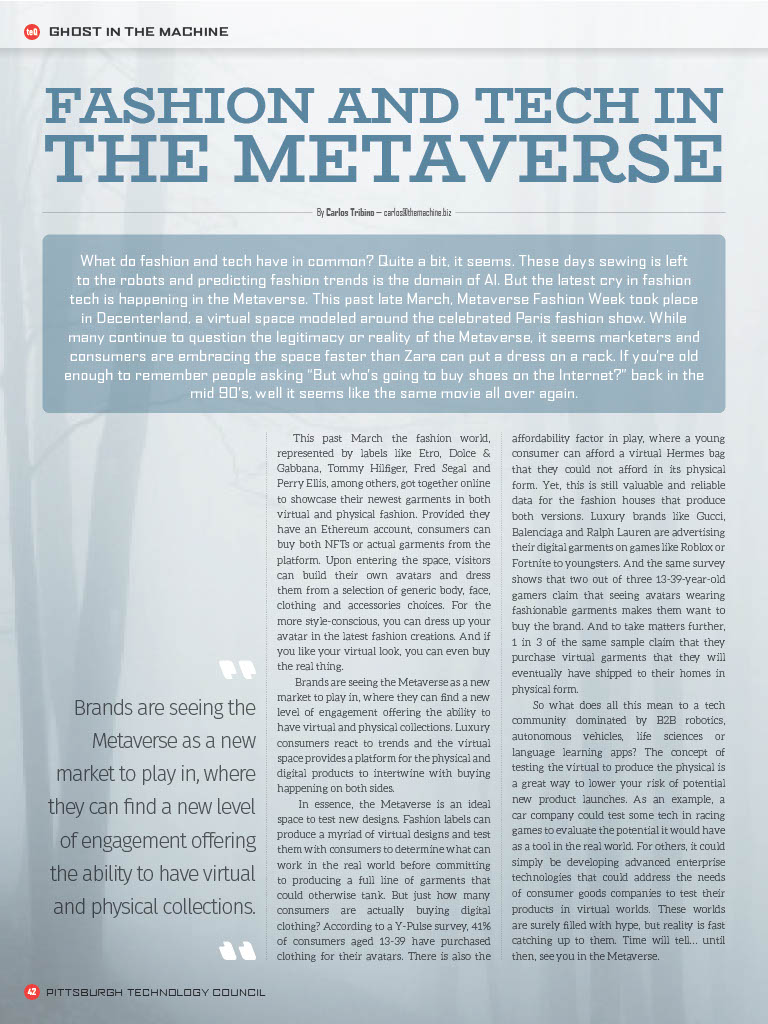Fashion and Tech in the Metaverse
Carlos Tribino
 What do fashion and tech have in common? Quite a bit, it seems. These days sewing is left to the robots and predicting fashion trends is the domain of AI. But the latest cry in fashion tech is happening in the Metaverse. This past late March, Metaverse Fashion Week took place in Decenterland, a virtual space modeled around the celebrated Paris fashion show. While many continue to question the legitimacy or reality of the Metaverse, it seems marketers and consumers are embracing the space faster than Zara can put a dress on a rack. If you’re old enough to remember people asking “But who’s going to buy shoes on the Internet?” back in the mid 90’s, well it seems like the same movie all over again.
What do fashion and tech have in common? Quite a bit, it seems. These days sewing is left to the robots and predicting fashion trends is the domain of AI. But the latest cry in fashion tech is happening in the Metaverse. This past late March, Metaverse Fashion Week took place in Decenterland, a virtual space modeled around the celebrated Paris fashion show. While many continue to question the legitimacy or reality of the Metaverse, it seems marketers and consumers are embracing the space faster than Zara can put a dress on a rack. If you’re old enough to remember people asking “But who’s going to buy shoes on the Internet?” back in the mid 90’s, well it seems like the same movie all over again.
This past March the fashion world, represented by labels like Etro, Dolce & Gabbana, Tommy Hilfiger, Fred Segal and Perry Ellis, among others, got together online to showcase their newest garments in both virtual and physical fashion. Provided they have an Ethereum account, consumers can buy both NFTs or actual garments from the platform. Upon entering the space, visitors can build their own avatars and dress them from a selection of generic body, face, clothing and accessories choices. For the more style-conscious, you can dress up your avatar in the latest fashion creations. And if you like your virtual look, you can even buy the real thing.
Brands are seeing the Metaverse as a new market to play in, where they can find a new level of engagement offering the ability to have virtual and physical collections. Luxury consumers react to trends and the virtual space provides a platform for the physical and digital products to intertwine with buying happening on both sides.
In essence, the Metaverse is an ideal space to test new designs. Fashion labels can produce a myriad of virtual designs and test them with consumers to determine what can work in the real world before committing to producing a full line of garments that could otherwise tank. But just how many consumers are actually buying digital clothing? According to a Y-Pulse survey, 41% of consumers aged 13-39 have purchased clothing for their avatars. There is also the affordability factor in play, where a young consumer can afford a virtual Hermes bag that they could not afford in its physical form. Yet, this is still valuable and reliable data for the fashion houses that produce both versions. Luxury brands like Gucci, Balenciaga and Ralph Lauren are advertising their digital garments on games like Roblox or Fortnite to youngsters. And the same survey shows that two out of three 13-39-year-old gamers claim that seeing avatars wearing fashionable garments makes them want to buy the brand. And to take matters further, 1 in 3 of the same sample claim that they purchase virtual garments that they will eventually have shipped to their homes in physical form.
So what does all this mean to a tech community dominated by B2B robotics, autonomous vehicles, life sciences or language learning apps? The concept of testing the virtual to produce the physical is a great way to lower your risk of potential new product launches. As an example, a car company could test some tech in racing games to evaluate the potential it would have as a tool in the real world. For others, it could simply be developing advanced enterprise technologies that could address the needs of consumer goods companies to test their products in virtual worlds. These worlds are surely filled with hype, but reality is fast catching up to them. Time will tell… until then, see you in the Metaverse.